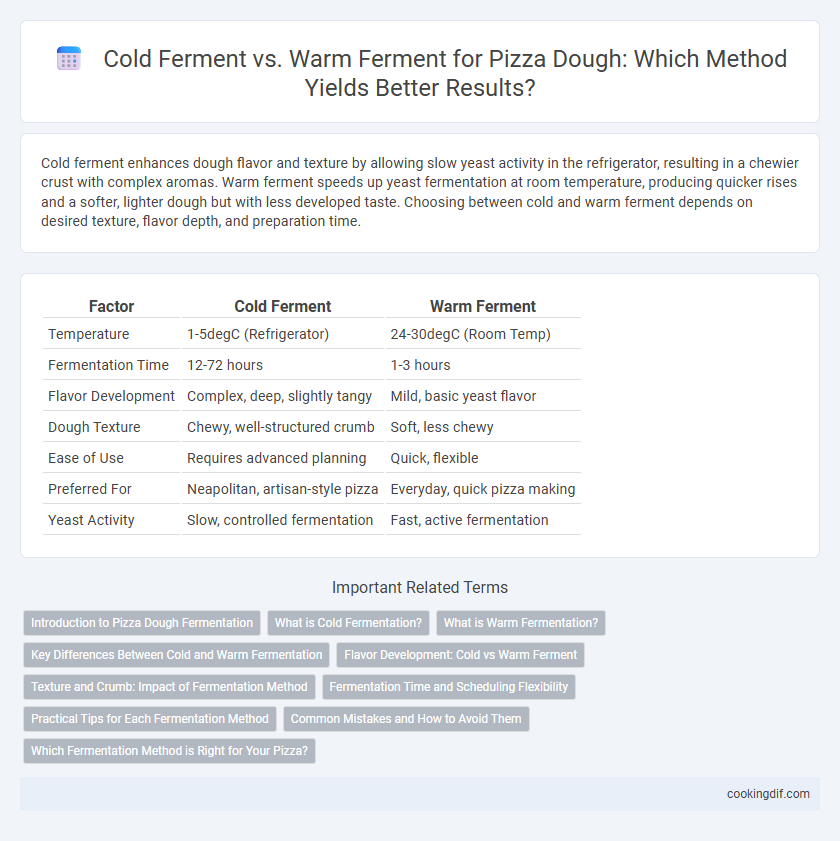Cold ferment enhances dough flavor and texture by allowing slow yeast activity in the refrigerator, resulting in a chewier crust with complex aromas. Warm ferment speeds up yeast fermentation at room temperature, producing quicker rises and a softer, lighter dough but with less developed taste. Choosing between cold and warm ferment depends on desired texture, flavor depth, and preparation time.
Table of Comparison
| Factor | Cold Ferment | Warm Ferment |
|---|---|---|
| Temperature | 1-5degC (Refrigerator) | 24-30degC (Room Temp) |
| Fermentation Time | 12-72 hours | 1-3 hours |
| Flavor Development | Complex, deep, slightly tangy | Mild, basic yeast flavor |
| Dough Texture | Chewy, well-structured crumb | Soft, less chewy |
| Ease of Use | Requires advanced planning | Quick, flexible |
| Preferred For | Neapolitan, artisan-style pizza | Everyday, quick pizza making |
| Yeast Activity | Slow, controlled fermentation | Fast, active fermentation |
Introduction to Pizza Dough Fermentation
Cold fermentation involves letting pizza dough rise slowly in a refrigerator for 24 to 72 hours, enhancing flavor complexity and dough texture through gradual yeast activity. Warm fermentation, typically conducted at room temperature for 1 to 3 hours, accelerates yeast metabolism, resulting in faster dough rise but less developed flavor. Understanding the fermentation process is crucial for controlling dough elasticity, crust crispness, and overall pizza quality.
What is Cold Fermentation?
Cold fermentation is a dough fermentation method where the pizza dough is allowed to rest and develop flavor in a refrigerated environment, typically between 36degF to 45degF (2degC to 7degC) for 24 to 72 hours. This slow, controlled process enhances gluten development, improves dough texture, and produces complex, tangy flavors due to the extended yeast activity. Cold ferment dough tends to have better elasticity and a crispier crust when baked at high temperatures.
What is Warm Fermentation?
Warm fermentation involves proofing pizza dough at a higher temperature, typically between 75degF to 85degF, which accelerates yeast activity and shortens fermentation time to a few hours. This method enhances dough elasticity and results in a softer crust with a slightly tangy flavor due to faster yeast metabolism. Bakers often choose warm fermentation for quicker dough preparation without sacrificing texture and taste.
Key Differences Between Cold and Warm Fermentation
Cold fermentation involves dough resting at low temperatures (typically 4degC) for 24-72 hours, allowing slow yeast activity and enhanced flavor development through extended enzymatic reactions. Warm fermentation occurs at higher temperatures (around 24-27degC) for a shorter period, usually 1-3 hours, resulting in faster yeast fermentation but less complex flavor profiles. The key differences include fermentation time, temperature control, and resultant dough texture, with cold fermentation yielding chewier crusts and more nuanced taste compared to the quicker, softer dough from warm fermentation.
Flavor Development: Cold vs Warm Ferment
Cold ferment enhances pizza dough flavor by slowing yeast activity, allowing complex organic acids and alcohols to develop over 24 to 72 hours, resulting in a richer, tangier taste. Warm ferment accelerates yeast fermentation, producing a milder flavor with a softer texture in 2 to 6 hours but less depth in aroma and complexity. Temperature control directly impacts enzymatic reactions and flavor compound formation, making cold fermentation ideal for artisanal pizzas seeking intense, nuanced flavor profiles.
Texture and Crumb: Impact of Fermentation Method
Cold fermentation produces a dough with a more complex flavor profile and a chewier, airy crumb due to slower yeast activity and extended enzymatic processes. Warm fermentation accelerates yeast activity, resulting in a softer, more tender texture but with less depth in flavor and a denser crumb. The choice between cold and warm ferment impacts the pizza crust's texture and internal structure, influencing chewiness and bubble distribution.
Fermentation Time and Scheduling Flexibility
Cold ferment extends dough fermentation from 24 to 72 hours at temperatures around 4degC, enhancing flavor complexity and allowing for flexible scheduling in professional kitchens. Warm ferment accelerates the process, typically completing fermentation within 2 to 6 hours at 24degC to 30degC, suitable for quick turnaround but with less developed taste. Efficient scheduling in pizzerias often balances warm ferment for immediate demand and cold ferment for batch preparation and flavor optimization.
Practical Tips for Each Fermentation Method
Cold ferment dough benefits from extended resting times of 24 to 72 hours in the refrigerator, enhancing flavor complexity and gluten development; shape the dough gently to preserve air bubbles before baking. Warm ferment requires a controlled environment at 75-85degF to activate yeast faster, typically fermenting in 1 to 3 hours; monitor dough rise closely to avoid overproofing and achieve optimal texture. Use cold ferment for richer taste and better dough handling, while warm ferment suits quick preparation and immediate baking needs.
Common Mistakes and How to Avoid Them
Cold ferment dough often suffers from under-proofing, causing dense texture, while warm ferment risks over-proofing with loss of flavor complexity. Common mistakes include incorrect temperature control, which can be avoided by maintaining a refrigerator temperature between 37degF-45degF for cold ferment and 75degF-85degF for warm ferment. Proper timing also matters; cold ferment should last 24-72 hours for optimal gluten development, whereas warm ferment typically requires 2-4 hours to prevent yeast exhaustion.
Which Fermentation Method is Right for Your Pizza?
Cold fermentation enhances dough flavor and texture by allowing yeast activity at lower temperatures over 24-72 hours, resulting in a more complex, chewy crust with improved digestibility. Warm fermentation accelerates yeast growth at room temperature, producing dough ready in a few hours with a lighter texture but less flavor depth. Choosing between cold and warm fermentation depends on whether you prioritize extended flavor development and texture complexity or faster dough preparation and a softer crust.
Cold ferment vs Warm ferment for dough Infographic

 cookingdif.com
cookingdif.com